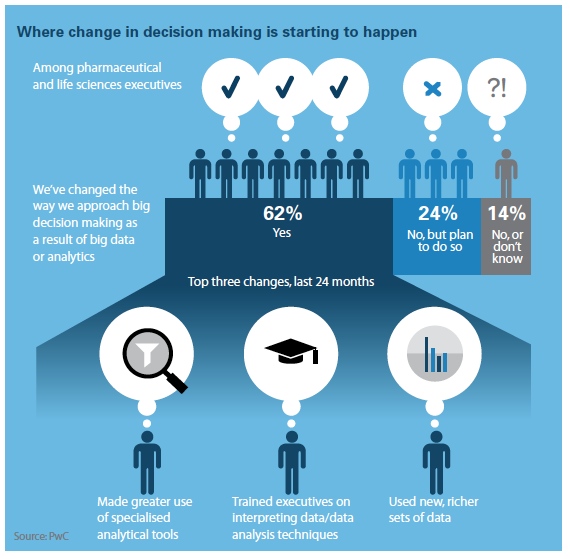 For life-sciences companies, there is tremendous wealth that can be tapped within a wide range of data relating to brands, products, physician practices, R&D, regulatory and compliance, formularies, rebates, and prescription use. When life-sciences organizations treat data as a strategic asset, they can transform their operations into analytic-driven leaders, gaining significant advantage.
For life-sciences companies, there is tremendous wealth that can be tapped within a wide range of data relating to brands, products, physician practices, R&D, regulatory and compliance, formularies, rebates, and prescription use. When life-sciences organizations treat data as a strategic asset, they can transform their operations into analytic-driven leaders, gaining significant advantage.
Over the past 10 years, the pharmaceutical and life-sciences industry has been flooded with data. And the information flow is not about to slow down. More data are expected generated by the proliferation of personal medical devices, social media, and electronic medical records. The global wearables market alone is expected to reach a value of $19 billion in 2018, according to Statista, more than 10 times its value from five years ago.
Big data and good analytics no doubt have the potential to transform the industry but only if companies can translate it into actionable business intelligence.
According to PwC’s 2014 global data and analytics survey, 62% of pharmaceuticals and life-sciences executives have changed their organizations’ approach to decision making as a result of data and analytics.
They’re using new, richer sets of data and training executives on the benefits of analytical techniques.
Another 24% haven’t made these types of changes yet, but they plan to do so.
The decision to create a new business model that focuses on real-world evidence and outcomes, redefine pipelines or seek new ways to enhance existing R&D models, or to partner with other companies to enhance adherence and healthy lifestyles, are just a few of the decisions that executives throughout the life-sciences industry are facing. And the decisions are huge. PwC reports that one-third of executives who participated in the survey value their next big decision at $1 billion or more.
PwC analysts say the plethora of newfound data made available by modern technologies and generated directly by consumers can give manufacturers valuable insight into how patients are using their products.
This information can help give payers the real-world evidence they demand to prove the efficacy and value of new drugs and devices. The challenge lies not in collecting this data, but in harnessing, parsing, and analyzing it to create competitive advantage. Insights and intelligence derived from fast-moving data sets can help inform strategy decisions, spur innovation, inspire new products, enhance customer relationships, and bolster operations.
Fortunately, say experts at SAS, a number of technology advancements have occurred or are under way that make it possible to benefit from big data and big data analytics. For starters, storage, server processing, and memory capacity have become abundant and cheap. The cost of a gigabyte of storage has dropped from approximately $16 in February 2000 to less than $0.07 today. Storage and processing technologies have been designed specifically for large data volumes. Computing models such as parallel processing, clustering, virtualization, grid environments and cloud computing, coupled with high-speed connectivity, have redefined what is possible. SAS has identified three key technologies that can help companies get a handle on big data – and even more importantly, extract meaningful business value from it.
Information management for big data. Manage data as a strategic, core asset, with ongoing process control for big data analytics.
High-performance analytics for big data. Gain rapid insights from big data and the ability to solve increasingly complex problems using more data.
Flexible deployment options for big data. Choose between options for on premises or hosted, software-as-a-service (SaaS) approaches for big data and big data analytics
Data and Privacy
PwC has identified four factors that will drive big data and privacy protections.
The first is laws and regulations. When state and national governments harmonize and enforce privacy and databreach laws and regulations, organizations will likely be inspired to report data breaches and share cybersecurity information without fear of penalty or litigation.
Organizations should be encouraged to adopt new approaches to cyber-breach notifications, reasonable-use policies, and cybersecurity information sharing.
The second factor is the openness of the Internet. Debates over the future of big data are based on a common assumption that the Internet will remain a series of open networks through which data easily flows. Some countries have begun to harden their Internet systems, and the concept of net neutrality is uncertain. If the Internet becomes a network of closed networks, or walled gardens, the full potential of big data may not be realized.
Technology is the third factor. Implementing automated privacy profiles across multiple sectors could help ensure that organization-sponsored personal privacy profiles are accessible and adopted by consumers.
Ease of use for customers across shopping channels, as well as genuine advances over current “notice and consent" systems, will be key. Commercial incentives from national and international bodies to invest in new privacy protection technologies could prove useful.
Finally, the fourth factor is regional innovation. Innovations in technological privacy protections in Asia and Africa may leapfrog big data analytics used in the United States and Europe.
The growing populations of Asia and Africa rely heavily on mobile technology for commerce and trade, and innovations in these areas could accelerate. Advances in digital payments, for instance, could provide new opportunities for adversaries to target and exploit payment systems. (PV)


















